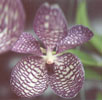|
|
|
|
|
| |
Flasks of
Vanda coerulea 'Alaura' × self |
|
| |
|
|
| |
|
|
Click to Enlarge

Pod Parent Flower |
Click to Enlarge

Pod Parent Flowers and bee carrying pollen |
|
|
|
| |
Culture Notes from Donor: Parent plant: Grows intermediate (60-83°F) and it likes a cool temperature drop at night in the winter.
Comments: I was in the greenhouse with a camera when a bee decided to pollinate one flower. (See picture.) I myself selfed a second flower taking the pollen from a third bloom.
Parent plant: Blooms frequently. Medium-sized plant.
For additional origin/habitat information supplied courtesy of
Charles and Margaret Baker, see further below, near the bottom of this page.
|
Temperatures we attempt to use in the lab & greenhouse:
| For Species: |
|
Spring: days average 83°F, nights 62°F; best fit is Intermediate 83-60°F
(Source:
Baker's Web OSC) |
| For Species: |
|
Summer, Autumn: days average 77°F, nights 64°F; best fit is Intermediate 83-60°F
(Source:
Baker's Web OSC) |
| For Species: |
|
Winter: days average 74°F, nights 46°F; best fit is Cool 70-52°F
(Source:
Baker's Web OSC) |
|
About the name...
| Etymology of |
coerulea |
|
From Latin "coeruleus" sky-blue.
(Source:
Mayr & Schmucker 1998) |
| Etymology of |
Vanda |
|
From Indian dialect "Vanda"; the name for orchids of the Vanda-like shape in the local Indian language.
(Source:
Mayr & Schmucker 1998) |
| Pronunciation of |
coerulea |
|
see-ROO-lee-ah
(Source:
Hawkes 1978) |
| Pronunciation of |
Vanda |
|
VAN-da
(Source:
Hawkes 1978) |
|
If you would like to direct someone to this web page, please copy and paste this URL into your email:
http://troymeyers.com/d?012881
| Flask Information |
| Availability: |
Seed not viable- failed. We were not able to make any flasks. |
| You should: |
Consider placing a "Notify Retries" Request, and if an identical pollination (the same parents) is done again, we'll let you know. |
|
You might also want to:
|
View the seed assay for this item.
View items of the same species.
View items of the same genus.
|
| Ordering Information |
| You are not currently logged in. |
|
You must be a registered user and be logged in to reserve a flask or place a notification request. Please log in:
|
|
|
|
|
|
| |
The origin/habitat information below is supplied courtesy of Charles and Margaret Baker
The following information is based on the name of the plant provided by the donor, and assumes that the name is correct. If the plant has been misidentified, then the following information may not be correct.
This text is copyrighted by the Bakers and may not be reproduced without permission.
ORIGIN/HABITAT: Northeast India, Burma, Thailand, and southwest China.
Discovered first in the Khasi (Khasia) Hills of northeast India, plants
have since been found in the mountain regions of Burma and northern
Thailand. They usually grow high up in rough-barked trees that are not
exceedingly leafy so that the plants are fully exposed to the sun, rain,
and wind. The roots sprawl over the dry rough bark with no moss or lichen
present. Therefore, they are able to dry very rapidly after becoming wet.
Over most of the range they are found at 3000-5000 ft. (910-1520 m), but
in Thailand cultivated plants reportedly grow well under natural
conditions in Chiang Mai which is at 1100 ft. (340 m).
More about this information and the Bakers...
|
|
|
| |
|
|
|